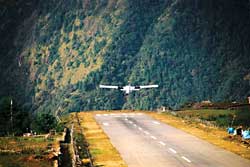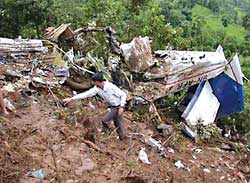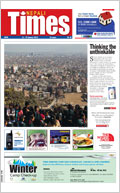 Civil Aviation Authority of Nepal (CAAN) records show there have been 56 aircraft accidents in Nepal since 1955, and 31 of the accidents occurred since the deregulation of domestic aviation in 1992 with a loss of 555 lives.
Civil Aviation Authority of Nepal (CAAN) records show there have been 56 aircraft accidents in Nepal since 1955, and 31 of the accidents occurred since the deregulation of domestic aviation in 1992 with a loss of 555 lives. One reason for this is that there has been a huge increase in the number of flights, and the high casualty rate was due to the crashes of the Thai and PIA Airbus 310s within two months of each other in 1992. Those two crashes and a majority of the 31 accidents in the past 12 years happened during the monsoon. All of them were classified as Controlled Flight Into Terrain (CFIT), which means an aircraft flying normally crashes into a mountain in bad weather.
 This monsoon was no different, and the pattern was set with the probable CFIT crash of a Yeti Airlines Twin Otter north of Lamjura Pass on 25 May. Something must be seriously wrong with our aviation safety procedures if so many crashes happened in the years since deregulation, especially if all of them took place during the monsoon due to the same causes. What is the problem that needs to be fixed here?
This monsoon was no different, and the pattern was set with the probable CFIT crash of a Yeti Airlines Twin Otter north of Lamjura Pass on 25 May. Something must be seriously wrong with our aviation safety procedures if so many crashes happened in the years since deregulation, especially if all of them took place during the monsoon due to the same causes. What is the problem that needs to be fixed here? Following accidents, an investigation panel is formed. It takes ages to complete, its reports are never made public, the files end up stacked in some cabinet in the offices of the Director General Civil Aviation (DGCA). In the skies above Nepal, it is soon back to normal, as if nothing happened. What is the use of investigating if the reports are never publicised and operators never get a chance to learn from past mistakes?
Nepal is notoriously difficult terrain to fly in even at the best of times and with the best navigation aid in the world. In bad weather, at night, with non-existent navaids and erratic procedures, things become much more uncertain.
Logically, with increasing sophistication of aircraft design and avionics the accident rate due to technical reasons are significantly reduced. But it is the human factor that dominates in Nepal. Human error doesn't always mean pilot error. Looking beyond the cockpit, these have to do with market pressures in which commercial airlines lean on their pilots to operate despite bad weather and with improper load structure. The management also exerts pressure because it is being forced by "higher authorities" to operate a flight despite poor flying conditions.
There is also pressure from passengers, especially in remote areas. I have even faced inflight situations where passengers try to persuade me to make one more attempt to land even though I have diverted from the destination due to bad weather. Deregulation has brought competition, which is a healthy thing, but when this competition gets cut-throat, airlines tend to cut corners with safety.
The ultimate responsibility for safety rests with pilots, and there can be several reasons for breakdowns in procedures: from a feeling of infallibility to machoness. Lack of training and route experience, fatigue and over-reliance on GPS equipment are other causes.
There is a worrying trend among Nepali pilots these days to make inappropriate and illegal use of GPS while inside clouds, even in the mountains, to develop individual routes and procedures based on satellite positioning and applying it in bad weather.
Finally, on the ground there is haphazardness of the DGCA to implement and enforce existing rules. Air traffic controllers need upgrading to cope with workload caused by flight frequency. We need better ground equipment for navigation, radar and standby systems for safety.
As domestic air transportation becomes even more important than before, there is an urgent need to remove the causes behind monsoon CFIT events.
 Cpt Vijay Lama has been flying for 17 years and has logged more than 10,000 hours. He currently heads the domestic operations of Royal Nepal Airlines.
Cpt Vijay Lama has been flying for 17 years and has logged more than 10,000 hours. He currently heads the domestic operations of Royal Nepal Airlines. 

